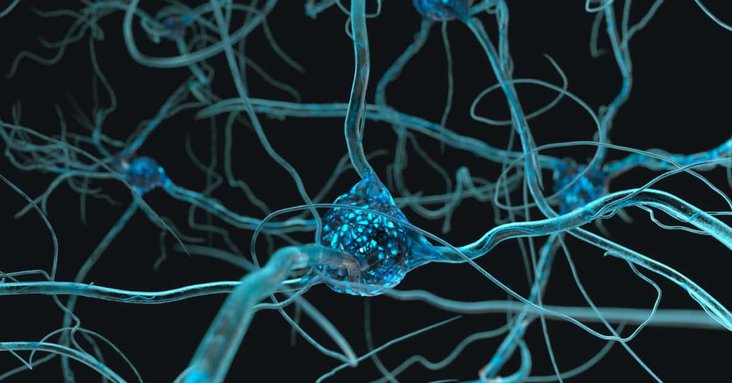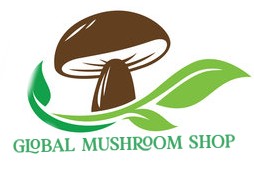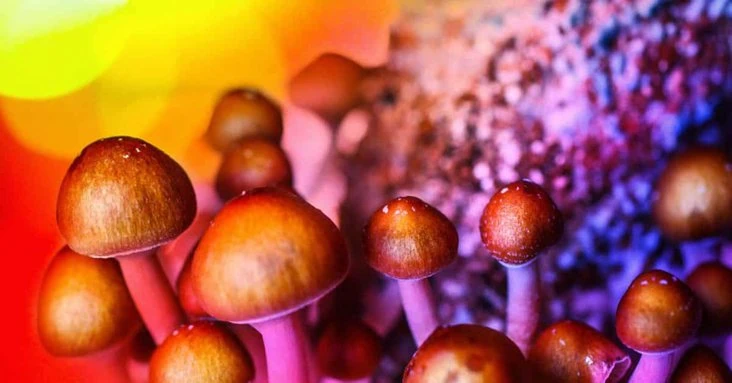Uncategorized
What is the Difference Between Psilocybin and LSD?
Introduction – What is a Psychedelic

So the first step to understanding the differences between LSD and the psilocybin found in magic mushrooms is to understand what they have in common – they are both psychoactive compounds that are grouped in the family of psychedelics.
Psychedelics are a specific class of hallucinogenic drug who cause “non-ordinary states of consciousness” (that’s a boring way to say “trips.”) They do this through a process called “serotonin receptor agnoism,” which is essentially what we call it when a chemical compound is capable of mimicking the effects of serotonin which is naturally produced in the body. Your serotonin receptors are separated into 7 categories – 5-HT1 through 5-HT7. Each of these types can have separate subtypes – these are lettered A, B, C, etc. Psychedelics like psilocybin and LSD specifically are specifically capable of binding with the 5-HT2A receptors. Although this is understood on a molecular level, the precise mechanics through which psychedelics are able to induce changes in cognition, mood, behavior and personality is a new frontier for neuroscience, and something that we are still only beginning to understand.
One thing that does seem to be consistent across all psychedelic drugs is that they reduce activity in the what’s called the default mode network of the human brain. This is a part of your brain is best known for being active during periods in which a person is not focused on things in the outside world. It is especially active during activities like daydreaming, and sometimes activated during cognitive planning phases, and when a person is thinking about others, about themselves, remembering the past and planning for the future. It’s thought that the reduced default mode network activity is one of the main ways psychedelics work, and the effect this reduction is similar to the ones that occur during meditation, mystical experiences, and near-death experiences.
Although research into psychedelics and the potential of psychedelic therapy experienced a bit of a Golden Age through the 1950s, The Single Convention on Narcotic Drugs of 1961 threw a monkey wrench into the works. This was a treaty signed by all members of the United Nations to prohibit the production and supply of drugs classified as “narcotics.” Although some exemptions were made for certain narcotics for medicinal uses and clinical experimentation, psychedelics at the time were not believed to have any legitimate medicinal uses, and it was made illegal to conduct any further research on the substances using human subjects.
This restriction slowed down the tide of research for obvious reasons, but psychedelics still remained widely popular as recreational drugs, and increasing droves of people began to report on the positive changes they experienced as a result of using psychedelics. Some dedicated researchers such as Terence McKenna and Alexander Shulgin continued to experiment with these substances (serving as their own subjects,) and writing about their experiences which has helped contribute to a growing understanding of the benefits of psilocybin we hear about so much today.
In 2021, as of the time of this writing, there are 21,000 papers on Google Scholar that make reference to the term “psychedelic,” with over half of these published after 2014. This is because psychedelics have become an increasingly hot-button issue in the world of therapy – with new results published every week, and the vast majority of them pointing in a singular direction: that psychedelics represent an unprecedented untapped resource in the treatment of a wide array of mental health disorders.
What is Psilocybin?

Okay, so we’ve talked about what psychedelics are and how they work, so let’s delve a little deeper into psilocybin to understand more specifically how it works. There’s a lot that we could say about psilocybin, but we’re going to focus for now on its pharmacological profile – that is to say, how exactly it behaves as a molecule and how it interacts with human body when consumed.
Psilocybin is the primary psychoactive ingredient found in psilocybin mushrooms, whose use predates written human history – and of which there are more than 200 separate strains that can be found all over the world. Psilocybin is what is technically referred to as a “prodrug” – that refers to a substance that, while not psychoactive itself, is metabolized by the body into a pharmacologically active drug. In this case, psilocybin when it is broken down through the process of human digestion is converted into psilocin – and when we talk about psilocybin as a serotonin agonist, we are actually referring to the product of psilocybin metabolism, psilocin.
When consumed it undergoes rapid dephosphorylation and is converted into psilocin. Psilocin binds with the highest affinity to 5-HT2A receptors, and with low affinity to 5-HT1A, 5HT1D and 5-HT2C receptors. As mentioned before, it’s thought that most of what one considers to be the “psychedelic experience” is a result of 5-HT2A agonism – although some have theorized that less predictable interactions with the other receptors could be responsible for variable reports in levels of anxiety, mood, and nausea.
It’s also noteworthy that psilocin has no distinguishable effect on the body’s dopaminergic system – meaning that there are no significant changes in the levels of dopamine produced by the body when ingesting psilocybin by itself. More on dopamine later.
It’s also worth noting that when we talk about “psilocybin,” the issue is further complicated by the fact that what we’re really talking about from a practical standpoint are psilocybin mushrooms. These are complex living organisms that are most often consumed in their entirety. That is to say, we are not independently synthesizing the compound psilocybin in a laboratory, but rather consuming these “magic mushrooms,” which contain not only psilocybin and psilocin, but a range of other possibly psychoactive compounds as well.
Baeocystin is an analog of psilocin that has been isolated in psilocybin mushrooms – that means it behaves similarly (though not identically) to psilocin, and there is considerably less research that has been done on baeocystin (about 450 published articles on Google Scholar, compared with 5,601 for psilocin and 21,000 for psilocybin.) Norpsilocin and norbaeocystin are other examples of compounds that have been isolated and identified only recently (in 2017), and whose truth we are only beginning to unfurl.
Another noteworthy psychoactive compound found in magic mushrooms in phenethylamine. Phenethylamine is a natural monoamine alkaloid that behaves as a central nervous stem stimulant by regulating monoamine transmission. Some phhenethylamine-based drugs are also incredibly popular recreationally such as 2-CB (or ‘“tucibi”), MDA (“sally”), and MDMA (“molly.”) Although psilocybin behaves radically differently from these drugs on a brain chemistry level, the presence of trace amounts of phenethylamine is still something that should be taken into consideration when considering the overall pharmacological profile of psilocybin mushrooms.
What is LSD?

Again, this is a question that can be answered in a number of different ways, but for the purposes of this article we are going to deal very briefly with the history and original origins of the drugs, and focus primarily on its pharmacological profile.
So, LSD (or Lysergic acid diethylamide, commonly known as “acid”) is a psychedelic drug that was first synthesized on November 16, 1938 by the Swiss chemist, Albert Hoffman in Basel, Switzerland. It was created with lysergic acid, which is a chemical derived from ergotamine – an enzyme found in the ergot fungus which grows on rye and other grains. Like many amazing scientific discoveries, LSD was something of an accident. Hoffman accidentally absorbed some LSD through his skin which caused him to first take note of its astounding effects. Later, on April 16 of 1943, Hoffman deliberately dosed himself with 250 µg of LSD and went for a bike ride. Needless to say, he was absolutely floored by the experience, and realized he’d stumbled on… something. Even if he didn’t know exactly what it would become at the time.
Since then, LSD has had a rich and colourful history, including a period of time where the CIA bought up the entire world’s supply of acid and conducted the now infamous MKUltra experiments over the course of 10 years, testing the substance on often unknowing subjects including members of the army, political prisoners, and many more. During the 1960s it was made illegal by the same UN Convention that outlawed mushrooms, but became an equally important part of a growing counterculture movement, and more recently has been explored as a potential therapeutic aid.
Chemically, LSD functions as a seretogenic agonist (like psilocybin), as well as a dopaminergic agonist. This means that it is capable of mimicking serotonin and dopamine. This makes it relatively unique in the world of psychedelics, as there are very few compounds that are both seretogenic and dopaminergic.
LSD can affect a wide range of different serotonin receptors, including 5-HT2A, 5-HT2B, and 5-HT2C. Also, there is an interesting distinction between the ways LSD interacts with serotonin receptors as compared with other psychedelics. When the LSD molecule fits into the serotonin receptors, it causes those receptors to fold in on themselves (imagine something like the lid closing overtop a wastebin.) This means that the LSD molecule remains in place until the lid “pops off”, and the molecule is capable of detaching. This results in the LSD trip being a significantly longer experience as compared with most other psychedelic drugs.
As for the dopamine system and D2 receptors, that forms the second major component of how LSD affects the brain. Dopamine is a neurotransmitter that is highly related to how we experience pleasure, how we set and achieve goals, and how we focus and motivate ourselves. There are many popular drugs such as cocaine, MDMA, and methamphetamine which function as “dopamine reuptake inhibitors.” Basically, stopping dopamine from being re-absorbed into the synaptic neurons after its released into the brain’s synaptic pathways, and causing increased concentrations of dopamine within those pathways.
Agonism, if you recall from our definition earlier, is very different than reuptake inhibition. An agonist mimics a naturally occurring neurotransmitter molecule, while the reuptake inhibitor dysregulates the body’s natural management of its own naturally occurring neurotransmitters. Dopamine agonists are not commonly used recreationally, however, they are used in the treatment of Parkinson’s disease, restless leg syndrome, and depression.
LSD’s agonism of dopamine receptors in addition to serotonin receptors are thought to be what gives it its unique psychoactive effects.
So What’s the Difference?
Once again, there are a lot of different ways to look at this, and psychedelics are something that we are just beginning to understand – but the following points represent the biggest differences:
1. Magic Mushrooms are grown organically, while LSD is synthesized in a lab
LSD was originally found from rye fungus, it’s true – but these days it is synthesized directly in a lab. This has a couple of ramifications, but the biggest one is that when you consume LSD, you are consuming a single concentrated molecule. When you’re eating shrooms, you’re eating an entire fungus – only 1-2% of whose weight is actually composed of psilocybin and psilocin. The other 98% is mostly non-psychoactive, but it’s impossible to discount the potential effects caused by the other psychoactive chemicals in psilocybin mushrooms. If you are looking to purchase magic mushrooms in Canada, you should make sure you find a reliable source!
2. LSD can affect both serotonin receptors and dopamine receptors, while psilocin only affects seretonin receptors.
As mentioned, these are both two completely distinct monoamines. Although psychedelic effects are commonly associated with serotonin receptor agonism, the dopamine receptor agonism likely plays a large role in the more energetic type of high that is often associated with LSD as compared with psilocybin.
3. Although both interact with 5-HT2A receptors with high synergy, the other seretonin receptors they affect are a little different.
Again, psychedelic effects are often thought to be associated with 5-HT2A receptor agonism, but the different seretonin receptors activated by the different molecules could be partially to explain for the different effects.
4. LSD can last much longer
This goes back to the unique “wastebin” trick of the LSD molecule when they bind to the seretonin receptor. While the psilocin molecule is almost always decoupled within 4-6 hours, once the LSD molecule bonds with the seretonin receptor, it creates a sort of lid that keeps it in place for up to 20 hours.

